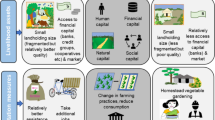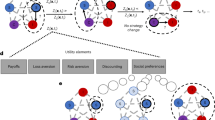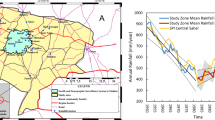Abstract
Climate change is anticipated to impact smallholder farmer livelihoods substantially. However, empirical evidence is inconclusive regarding how increased climate stress affects smallholder farmers’ deployment of various livelihood strategies, including rural–urban migration. Here we use an agent-based model to show that in a South Asian agricultural community experiencing a 1.5 oC temperature increase by 2050, climate impacts are likely to decrease household income in 2050 by an average of 28%, with fewer households investing in both economic migration and cash crops, relative to a stationary climate. Pairing a small cash transfer with risk transfer mechanisms significantly increases the adoption of migration and cash crops, improves community incomes and reduces community inequality. While specific results depend on contextual factors such as risk preferences and climate risk exposure, these interventions are robust in improving adaptation outcomes and alleviating immobility, by addressing the intersection of risk aversion, financial constraints and climate impacts.
This is a preview of subscription content, access via your institution
Access options
Access Nature and 54 other Nature Portfolio journals
Get Nature+, our best-value online-access subscription
$29.99 / 30 days
cancel any time
Subscribe to this journal
Receive 12 print issues and online access
$209.00 per year
only $17.42 per issue
Buy this article
- Purchase on Springer Link
- Instant access to full article PDF
Prices may be subject to local taxes which are calculated during checkout





Similar content being viewed by others
Data availability
The agent-based model from which results are generated is available via a public GitHub repository at: https://github.com/nchoquettelevy/RiskTransferClimateImmobilityABM.
Code availability
The code for the agent-based model developed in this study is available via a public GitHub repository at: https://github.com/nchoquettelevy/RiskTransferClimateImmobilityABM.
References
Howden, S. M. et al. Adapting agriculture to climate change. Proc. Natl Acad. Sci. USA 104, 19691–19696 (2007).
Huang, J., Yu, H., Guan, X., Wang, G. & Guo, R. Accelerated dryland expansion under climate change. Nat. Clim. Change 6, 166–171 (2015).
McLeman, R. & Smit, B. Migration as an adaptation to climate change. Clim. Change 76, 31–53 (2006).
Bohra-Mishra, P., Oppenheimer, M. & Hsiang, S. Nonlinear permanent migration response to climatic variations but minimal response to disasters. Proc. Natl Acad. Sci. USA 111, 9780–9785 (2014).
Migration and Global Environmental Change: Future Challenges and Opportunities (The Government Office for Science, 2011); https://assets.publishing.service.gov.uk/government/uploads/system/uploads/attachment_data/file/287717/11-1116-migration-and-global-environmental-change.pdf
Hoffmann, R., Dimitrova, A., Muttarak, R., Cuaresma, J. C. & Peisker, J. A meta-analysis of country-level studies on environmental change and migration. Nat. Clim. Change 10, 904–912 (2020).
Adger, W. N., Arnell, N. W. & Tompkins, E. L. Successful adaptation to climate change across scales. Glob. Environ. Change 15, 77–86 (2005).
Linnerooth-Bayer, J. & Hochrainer-Stigler, S. Financial instruments for disaster risk management and climate change adaptation. Clim. Change 133, 85–100 (2015).
Surminski, S., Bouwer, L. M. & Linnerooth-Bayer, J. How insurance can support climate resilience. Nat. Clim. Change 6, 333–334 (2016).
Gray, C. L. & Mueller, V. Natural disasters and population mobility in Bangladesh. Proc. Natl Acad. Sci. USA 109, 6000–6005 (2012).
Marotzke, J., Semmann, D. & Milinski, M. The economic interaction between climate change mitigation, climate migration, and poverty. Nat. Clim. Change 10, 518–525 (2020).
Gray, J., Hilton, J. & Bijak, J. Choosing the choice: reflections on modelling decisions and behavior in demographic agent-based models. Popul. Stud. 71, 85–97 (2017).
Klabunde, A. & Willekens, F. Decision-making in agent-based models of migration: state of the art and challenges. Eur. J. Popul. 32, 73–97 (2016).
Thober, J., Schwarz, N. & Hermans, K. Agent-based modeling of environment-migration linkages: a review. Ecol. Soc. 23, 41 (2018).
Massey, D. S. et al. Theories of international migration: a review and appraisal. Popul. Dev. Rev. 19, 431–466 (1993).
Taylor, J. E. The New Economics of Labour Migration and the role of remittances in the migration process. Int. Migr. 37, 63–86 (1999).
Grimm, V. et al. Pattern-oriented modeling of agent-based complex systems: lessons from ecology. Science 310, 987–991 (2005).
National Population and Housing Census (Government of Nepal, National Planning Commission Secretariat Central Bureau of Statistics, 2011); https://unstats.un.org/unsd/demographic-social/census/documents/Nepal/Nepal-Census-2011-Vol1.pdf
Aryal, J. P. et al. Climate change and agriculture in South Asia: adaptation options in smallholder production systems. Environ. Dev. Sustain. 22, 5045–5075 (2020).
Ghimire, D. J., Axinn, W. G., Bhandari, P. B., Bhandari, H. & Thornton, R. Chitwan Valley Family Study: Labour Outmigration, Agricultural Productivity and Food Security, Nepal, 2015–2017 (DSDR, 2021) https://www.icpsr.umich.edu/web/DSDR/studies/36755
Katovich, E. Costs and returns of grain and vegetable crop production in Nepal’s Mid-Western Development Region. https://conservancy.umn.edu/handle/11299/165366 (2014).
Shrestha, M. Push and Pull: A Study of International Migration from Nepal Working Paper 7965 (World Bank Group, 2017).
Mohan, S. Risk aversion and certification: evidence from the Nepali tea fields. World Dev. 129, 104903 (2020).
Almazroul, M., Saeed, S., Saeed, F., Islam, M. N. & Ismail, M. Projections of precipitation and temperature over the South Asian countries in CMIP6. Earth Syst. Environ. 4, 297–320 (2020).
Tanaka, T., Camerer, C. F. & Nguyen, Q. Risk and time preferences: linking experimental and household survey data from Vietnam. Am. Econ. Assoc. 100, 557–571 (2010).
Benveniste, H., Oppenheimer, M. & Fleurbaey, M. Effect of border policy on exposure and vulnerability to climate change. Proc. Natl Acad. Sci. USA 117, 26692–26702 (2020).
Budhathoki, N. K., Lassa, J. A., Pun, S. & Zander, K. K. Farmers’ interest and willingness-to-pay for index-based crop insurance in the lowlands of Nepal. Land Use Policy 85, 1–10 (2019).
Holmes, R. & Uphadya, S. The Role of Cash Transfers in Post-Conflict Nepal (Overseas Development Institute, 2009) https://www.calpnetwork.org/wp-content/uploads/2021/08/odi-the-role-of-ctp-in-post-conflict-nepal-aug-2009.pdf
Hill, R. V. et al. Ex ante and ex post effects of hybrid index insurance in Bangladesh. J. Dev. Econ. 136, 1–17 (2019).
Prifti, E., Daidone, S., Pace, N. & Davis, B. Heterogeneous impacts of cash transfers on farm profitability. evidence from a randomised study in Lesotho. Eur. Rev. Agric. Econ. 47, 1531–1558 (2020).
Dasgupta, P. The economics of poverty in poor countries. Scand. J. Econ. 100, 41–68 (1998).
Fafchamps, M. & Gubert, F. The formation of risk sharing networks. J. Dev. Econ. 83, 326–350 (2007).
KC, B. & Race, D. Outmigration and land-use change: a case study from the Middle Hills of Nepal. Land 9, 2 (2020).
Beckage, B. et al. Linking models of human behaviour and climate alters projected climate change. Nat. Clim. Change 8, 79–84 (2018).
O’Neill, B. C. et al. The roads ahead: narratives for shared socioeconomic pathways describing world futures in the 21st century. Glob. Environ. Change 42, 169–180 (2017).
Haer, T., Botzen, W. J. W. & Jeroen, C. J. H. A. Advancing disaster policies by integrating dynamic adaptive behaviour in risk assessments using an agent-based modelling approach. Environ. Res. Lett. 14, 044022 (2019).
de Koning, K. & Filatova, T. Repetitive floods intensify outmigration and climate gentrification in coastal cities. Environ. Res. Lett. 15, 034008 (2020).
Kremmydas, D., Athanasiadis, I. N. & Rozakis, S. A review of agent based modeling for agricultural policy evaluation. Agric. Syst. 164, 95–106 (2018).
van Duinen, R., Filatova, T., Jager, W. & van der Veen, A. Going beyond perfect rationality: drought risk, economic choices and the influence of social networks. Ann. Reg. Sci. 57, 335–369 (2016).
Wossen, T. & Berger, T. Climate variability, food security and poverty: agent-based assessment of policy options for farm households in Northern Ghana. Environ. Sci. Policy 47, 95–107 (2015).
Groenveld, J. et al. Theoretical foundations of human decision-making in agent-based land use models – a review. Environ. Model. Softw. 87, 39–48 (2017).
Kniveton, D. R., Smith, C. D. & Black, R. Emerging migration flows in a changing climate in dryland Africa. Nat. Clim. Change 2, 444–447 (2012).
Hassani-Mahmooei, B. & Parris, B. W. Climate change and internal migration patterns in Bangladesh: an agent-based model. Environ. Dev. Econ. 17, 763–780 (2012).
Smith, C. D. Modelling migration futures: development and testing of the Rainfalls Agent-Based Migration Model – Tanzania. Clim. Dev. 6, 77–91 (2014).
Entwistle, B. et al. Climate shocks and migration: an agent-based modeling approach. Popul. Environ. 38, 47–71 (2016).
Hailegiorgis, A., Crooks, A. & Cioffi-Revilla, C. An agent-based model of rural households’ adaptation to climate change. J. Artificial Soc. Soc. Simul. 21, 4 (2018).
Bell, A., Calvo, C. & Oppenheimer, M. Migration, intensification, and diversification as adaptive strategies. Socioenviron. Syst. Modeling https://sesmo.org/article/view/16102 (2019).
Freund, R. J. The introduction of risk into a programming model. Econometrica 24, 253–263 (1956).
Markowitz, H. M. Foundations of portfolio theory. J. Finance 46, 469–477 (1991).
Lucas, R. E. B. & Stark, O. Motivations to remit: evidence from Botswana. J. Polit. Econ. 93, 901–918 (1985).
Taylor, J. E. The New Economics of Labour Migration and the role of remittances in the migration process. Int. Migr. 37, 63–86 (1999).
Massey, D. S. et al. Theories of international migration: a review and appraisal. Popul. Dev. Rev. 19, 431–466 (1993).
Choquette-Levy, N. & Wildemeersch, M. Risk transfer climate immobility ABM. Zendo (14 September 2021; https://doi.org/10.5281/zenodo.5508089
Simon, H. A. in Decision and Organization (eds McGuire, C. B. & Radner, R.) 161–176 (Univ. of Minnesota Press, 1972).
Yang, D. & Choi, H. Are remittances insurance? Evidence from rainfall shocks in the Philippines. World Bank Econ. Review. 21, 219–248 (2007).
Weber, E. U. & Johnson, E. J. in Neuroeconomics: Decision Making and the Brain (eds Glimcher, P. M. et al.) Ch. 10, 127–144 (Academic Press, 2009).
Barabási, A.-L. & Albert, R. Emergence of scaling in random networks. Science 286, 509–512 (1999).
Taylor, J. E. & Martin, P. L. in Handbook of Agricultural Economics Vol. 1 (eds Gardner, B. & Rausser, G.) 458–503 (North-Holland, 2001).
Massey, D. S. & Espana, F. G. The social process of international migration. Science 237, 733–738 (1987).
Silva, A. C. & Massey, D. S. Violence, networks, and international migration from Colombia. Int. Migr. https://migrationresearch.com/item/violence-networks-and-international-migration-from-colombia/492152 (2014).
Lutz, W. & Muttarak, R. Forecasting societies’ adaptive capacities through a demographic metabolism model. Nat. Clim. Change 7, 177–184 (2017).
Striessnig, E., Lutz, W. & Patt, A. G. Effects of educational attainment on climate vulnerability. Ecol. Soc. 18, 16 (2013).
Samir, K. C., Wurzer, M., Speringer, M. & Lutz, W. Future population and human capital in heterogeneous India. Proc. Natl Acad. Sci. USA 115, 8328–8333 (2018).
Edirisinghe, J. C. Smallholder farmers’ wealth and livelihood choices in developing countries: a Sri Lankan case study. Econ. Anal. Policy 45, 33–38 (2015).
Nielsen, T., Keil, A. & Zeller, M. Assessing farmers’ risk preferences and their determinants in a marginal upland area of Vietnam: a comparison of multiple elicitation techniques. Agric. Econ. 44, 255–273 (2013).
Bro, A. S. Climate change adaptation, food security, and attitudes toward risk among smallholder coffee farmers in Nicaragua. Sustainability 12, 6946 (2020).
Mulwa, C., Marenya, P., Rahut, D. B. & Kassie, M. Responses to climate risks among smallholder farmers in Malawi: a multivariate probit assessment of the role of information, household demographics, and farm characteristics. Clim. Risk Manag. 16, 208–221 (2017).
Howden, S. M. et al. Adapting agriculture to climate change. Proc. Natl Acad. Sci. USA 104, 19691–19696 (2007).
Lobell, D. B., Schlenker, W. & Costa-Roberts, J. Climate trends and global crop production since 1980. Science 333, 616–620 (2011).
Chen, S., Chen, X. & Xu, J. Impacts of climate change on agriculture: evidence from China. J. Environ. Econ. Manag. 76, 105–124 (2016).
Feng, S., Krueger, A. B. & Oppenheimer, M. Linkages among climate change, crop yields, and Mexico-US cross-border migration. Proc. Natl Acad. Sci. USA 107, 14257–14262 (2010).
Lobell, D. B. & Field, C. B. Global scale climate-crop yield relationships and the impacts of recent warming. Environ. Res. Lett. 2, 014002 (2007).
Zampieri, M., Ceglar, A., Dentener, F. & Toreti, A. Wheat yield loss attributable to heat waves, drought, and water excess at the global, national, and subnational scales. Environ. Res. Lett. 12, 064008 (2017).
Li, Y., Ye, W., Wang, M. & Yan, X. Climate change and drought: a risk assessment of crop-yield impacts. Clim. Res. https://www.semanticscholar.org/paper/Climate-change-and-drought%3A-a-risk-assessment-of-Li-Ye/4816306e3883733d1c4cf2028394f693d6cbb734 (2009).
Ming, B. et al. SPEIpm-based research on drought impact on maize yield in North China Plain. J. Integr. Agric. 14, 660–669 (2014).
IPCC Climate Change 2014: AR5 Synthesis Report (eds Core Writing Team, Pachauri, R. K. & Meyer, L. A.) (Cambridge Univ. Press, 2014).
IPCC Managing the Risks of Extreme Events and Disasters to Advance Climate Change Adaptation (Cambridge Univ. Press, 2012).
Vicente-Serrano, S. M. et al. Performance of drought indices for ecological, agricultural, and hydrological applications. Earth Interact. 16, 1–27 (2012).
Saville, N. M. et al. Impact on birth weight and child growth of participatory learning and action women’s groups with and without transfers of food or cash during pregnancy: findings of the Low Birth Weight South Asia Cluster-Randomised Controlled Trial (LBWSAT) in Nepal. PLoS ONE 13, e0194064 (2018).
Katovich, E. & Sharma, A. Costs and Returns of Grain and Vegetable Crop Production in Nepal’s Mid-Western Development Region (US AID, Winrock Intenational, 2014).
Acknowledgements
We authors thank four anonymous reviewers for helpful comments that improved the quality of this manuscript. N.C.-L. thanks the Center for Policy Research on Energy and the Environment at Princeton University and the Young Summer Scientists Program at the International Institute of Applied Systems Analysis for financial and organizational support, and the National Academy of Sciences and the Social Sciences and Humanities Research Council of Canada (no. 752-2020-077) for financial support.
Author information
Authors and Affiliations
Contributions
N.C.-L. and M.W. conceived of and developed an initial design for the study. M.O. and S.L. proposed modifications incorporated in the final design. N.C.-L. wrote the model code. N.C.-L. and M.W. analysed model results. All authors contributed to drafting the manuscript, responding to reviewer comments and producing the final version. Correspondence and requests for materials should be addressed to N.C.-L. (nc8@princeton.edu) or M.O. (omichael@princeton.edu).
Corresponding author
Ethics declarations
Competing interests
The authors declare no competing interests.
Additional information
Peer review information Nature Climate Change thanks Roman Hoffmann, Jonathan Gilligan and the other, anonymous, reviewer(s) for their contribution to the peer review of this work.
Publisher’s note Springer Nature remains neutral with regard to jurisdictional claims in published maps and institutional affiliations.
Supplementary information
Supplementary Information
Supplementary Sections 1 (additional background material), 2 (methods) and 3 (results), Tables 1–5 and Figs. 1–16.
Rights and permissions
About this article
Cite this article
Choquette-Levy, N., Wildemeersch, M., Oppenheimer, M. et al. Risk transfer policies and climate-induced immobility among smallholder farmers. Nat. Clim. Chang. 11, 1046–1054 (2021). https://doi.org/10.1038/s41558-021-01205-4
Received:
Accepted:
Published:
Issue Date:
DOI: https://doi.org/10.1038/s41558-021-01205-4
This article is cited by
-
Prosocial preferences improve climate risk management in subsistence farming communities
Nature Sustainability (2024)
-
Risk-adjusted decision making can help protect food supply and farmer livelihoods in West Africa
Communications Earth & Environment (2024)
-
The effects of environmental and non-environmental shocks on livelihoods and migration in Tanzania
Population and Environment (2024)
-
Risk transfers support adaptation
Nature Climate Change (2021)



